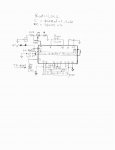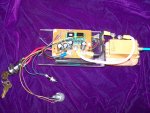Alaskan
0
- Joined
- Jan 29, 2014
- Messages
- 12,025
- Points
- 113
Robert, I've been eyeing some ytterbium fiber lasers on ebay, prices always high, or the equipment suspect as being something pulled out of the trash somewhere and listed on ebay. I would also be interested if someone here has had a chance to work with one, or owns one.
Paul, I did enjoy burning some cardboard with one of these FAP's, but not my reason for buying it.
Here's a photo of the collimation lens I used in the photo's shown on page one of this thread, it came out of one of those 473 nm medical DPSS units which I sent you, it is screwed into that splitter module on the front of the unit the fiber cables go into and come out of. It's really not an IR lens, as you are aware, but also is without AR coating, so can be used at IR anyway. I don't know how much the back reflection can cause a problem, Mike had one of his units get a fried FAP output due to a back reflection somehow, but mine have never failed, yet. There is a ebay seller in Ukraine listing one of these lenses right now for close to 100 dollars, listing it as an IR collimator, BS! It wasn't made for that.





You can see what the high mRad of the FAP is with this 12.7 mm diameter collimation lens, 15 feet away and the spot is as big as my hand. Near the output of the lens the beam is only a very few mm wide, but sure gets wide fast a few feet away. Looking at these pictures again today I've come to think the output might not be fully collimated, look at how tiny the beam is leaving the lens in photo #3.
Paul, I did enjoy burning some cardboard with one of these FAP's, but not my reason for buying it.
Here's a photo of the collimation lens I used in the photo's shown on page one of this thread, it came out of one of those 473 nm medical DPSS units which I sent you, it is screwed into that splitter module on the front of the unit the fiber cables go into and come out of. It's really not an IR lens, as you are aware, but also is without AR coating, so can be used at IR anyway. I don't know how much the back reflection can cause a problem, Mike had one of his units get a fried FAP output due to a back reflection somehow, but mine have never failed, yet. There is a ebay seller in Ukraine listing one of these lenses right now for close to 100 dollars, listing it as an IR collimator, BS! It wasn't made for that.





You can see what the high mRad of the FAP is with this 12.7 mm diameter collimation lens, 15 feet away and the spot is as big as my hand. Near the output of the lens the beam is only a very few mm wide, but sure gets wide fast a few feet away. Looking at these pictures again today I've come to think the output might not be fully collimated, look at how tiny the beam is leaving the lens in photo #3.
Last edited:








 P1010579
P1010579 P1010573
P1010573

